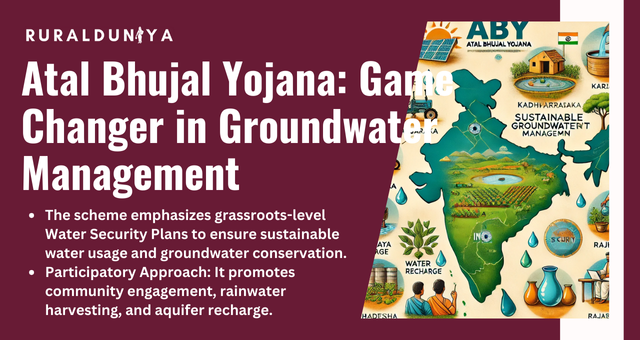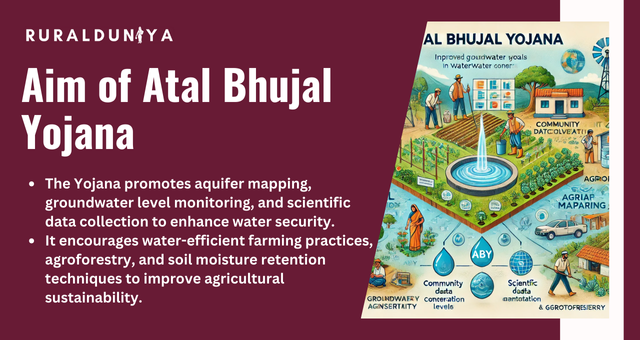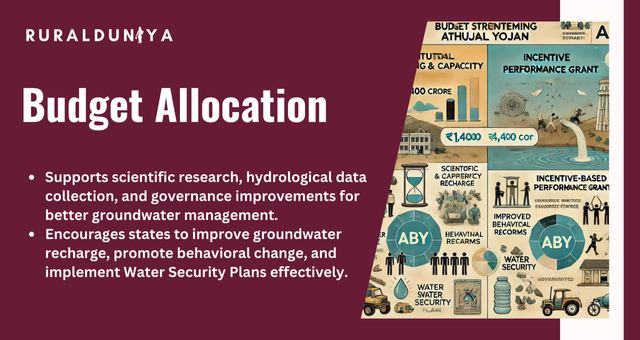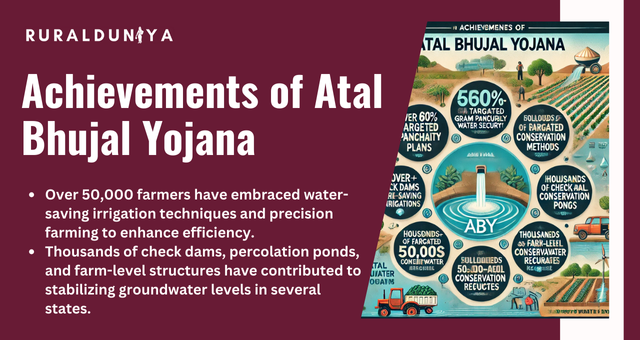Water scarcity is one of the most pressing issues in India. To tackle this problem, the Government of India launched Atal Bhujal Yojana (Atal Jal) on December 25, 2019.
This central sector scheme, with a total outlay of ₹6,000 crore, aims to improve groundwater management through community participation, sustainable water use, and efficient irrigation techniques.
Atal Bhujal Yojana: Game Changer in Groundwater Management

Atal Bhujal Yojana (ABY) to promote sustainable groundwater management, water resource conservation, and participatory governance. India is the largest user of groundwater in the world, extracting over 250 cubic kilometers of groundwater annually for drinking, agriculture, and industrial use.
However, indiscriminate extraction has resulted in the overexploitation of groundwater in more than 1,000 blocks across 19 states. The scheme is designed to address water-stressed Gram Panchayats covering 8,220 Gram Panchayats, 229 blocks, and 80 districts across the seven participating states.
It emphasizes the preparation and implementation of Water Security Plans (WSPs) at the grassroots level, encouraging water budgeting, rainwater recharge techniques, and convergence of existing schemes for effective groundwater conservation.
The scheme is being implemented over five years (2020-2025) in seven states: Gujarat, Haryana, Karnataka, Madhya Pradesh, Maharashtra, Rajasthan, and Uttar Pradesh. It focuses on scientific water conservation techniques, rainwater harvesting, and aquifer recharge to combat water stress in identified areas.
Objectives of Atal Bhujal Yojana
The primary objective of the Yojana is to ensure sustainable groundwater management through a community-driven approach. The specific objectives include:
- Strengthening institutional frameworks for groundwater management.
- Developing Water Security Plans at the Gram Panchayat level.
- Encouraging demand-side management through techniques like drip irrigation, watershed management, and climate-resilient farming.
- Enhancing supply-side interventions by constructing recharge structures like check dams, percolation tanks, and farm ponds.
- Building community awareness through education, participatory rural appraisals, and training programs.
- Ensuring equitable access to groundwater resources to benefit both agricultural and domestic users.
Aim of Atal Bhujal Yojana

The Yojana aims to:
- Improve groundwater levels in critical and over-exploited areas.
- Encourage community ownership and responsibility for groundwater conservation.
- Promote scientific data collection, aquifer mapping, and groundwater level monitoring.
- Integrate various government schemes to enhance water security and climate resilience.
- Support farmers in adopting water-efficient agricultural practices, soil moisture retention techniques, and agroforestry.
By addressing both demand-side and supply-side factors, the scheme seeks to arrest groundwater depletion and improve agricultural water management in rural India.
World Bank Collaboration
The World Bank is a major partner in the implementation of Yojana, providing 50% of the total funding through a loan of ₹3,000 crore. The remaining ₹3,000 crore is funded by the Government of India as grants-in-aid to the participating states.
The World Bank’s involvement ensures the use of global best practices in groundwater management, monitoring, and community engagement. It also brings technical expertise in hydrogeology, financial discipline, and participatory governance, enhancing the overall efficiency and impact of the scheme.
Budget Allocation

The scheme’s ₹6,000 crore budget is allocated into two key components:
- Institutional Strengthening & Capacity Building (₹1,400 crore): Supports scientific data collection, hydrological research, governance reforms, and institutional capacity-building.
- Incentive-Based Performance Grant (₹4,600 crore): Rewards states based on their achievement of key performance indicators, including improved groundwater recharge, behavioral change, and successful implementation of Water Security Plans.
Implementation in Key States
Madhya Pradesh
- Covers six districts, nine blocks, and 670 Gram Panchayats.
- Received ₹6.33 crore (2020-21) and ₹46.57 crore (2021-22).
- Focus on community-led groundwater conservation, micro-irrigation systems, and rainwater harvesting.
Rajasthan
- Covers 17 districts, 38 blocks, and 1,132 Gram Panchayats.
- Received ₹22.05 crore (2020-21) and ₹46.35 crore (2021-22).
- Emphasizes reviving traditional water harvesting structures like stepwells, Johads, and Khadins.
Uttar Pradesh
- Covers 10 districts, 26 blocks, and 549 Gram Panchayats.
- Received ₹7.69 crore (2020-21) and ₹32.33 crore (2021-22).
- Promotes water-efficient cropping patterns, watershed development, and rainwater harvesting.
Haryana
- Covers 14 districts, 36 blocks, and 1,647 Gram Panchayats.
- Received ₹20.80 crore (2020-21) and ₹32.15 crore (2021-22).
- Focuses on crop diversification, groundwater recharge techniques, and community participation.
Gujarat
- Covers 8 districts, 20 blocks, and 1,062 Gram Panchayats.
- Received ₹10.45 crore (2020-21) and ₹28.50 crore (2021-22).
- Implements integrated watershed management, groundwater monitoring systems, and aquifer recharge.
Achievements of Atal Bhujal Yojana

- Over 60% of targeted Gram Panchayats have prepared and implemented Water Security Plans.
- More than 50,000 farmers have adopted water-saving irrigation methods and precision farming.
- Construction of thousands of check dams, percolation ponds, and farm-level water conservation structures has enhanced groundwater recharge.
- Several states have reported stabilization or improvement in groundwater levels in intervention areas.
- Community participation in groundwater governance has significantly increased.
What to Remember
Atal Bhujal Yojana is a landmark initiative that addresses India’s critical issue—groundwater depletion. By integrating scientific water conservation techniques, participatory governance, and financial incentives, the scheme is empowering rural communities to manage water resources efficiently.
As the scheme progresses, its success will serve as a model for nationwide groundwater conservation, climate resilience, and water security. With continued stakeholder participation, Yojana can pave the way for a water-secure India.
FAQs
What is Atal Bhujal Yojana?
It is a government scheme launched in 2019 to improve groundwater management in India through community participation and water conservation techniques.
Which states are covered under Atal Bhujal Yojana?
The scheme is implemented in seven states: Gujarat, Haryana, Karnataka, Madhya Pradesh, Maharashtra, Rajasthan, and Uttar Pradesh.
How does Atal Bhujal Yojana help in groundwater conservation?
It promotes rainwater harvesting, efficient irrigation, aquifer recharge, and awareness programs to reduce excessive groundwater use and improve sustainability.
Who funds Atal Bhujal Yojana?
The scheme is 50% funded by the World Bank and 50% by the Government of India, ensuring financial support for its effective implementation.

Nishank is a social impact enthusiast with a solid foundation in public policy, micro-enterprise, and agribusiness. Growing up in a farmer’s family has given him a profound connection to rural communities, fueling his passion to empower people towards self-reliance. He completed his undergraduate studies at the Delhi University and earned a master’s degree in Rural Management from National Institute of Rural Development & Panchayati Raj in Hyderabad.



